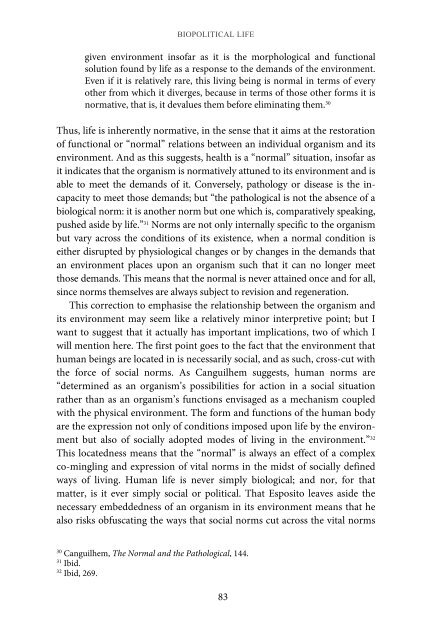Foucault, Biopolitics, and Governmentality
Foucault, Biopolitics, and Governmentality
Foucault, Biopolitics, and Governmentality
You also want an ePaper? Increase the reach of your titles
YUMPU automatically turns print PDFs into web optimized ePapers that Google loves.
BIOPOLITICAL LIFE<br />
given environment insofar as it is the morphological <strong>and</strong> functional<br />
solution found by life as a response to the dem<strong>and</strong>s of the environment.<br />
Even if it is relatively rare, this living being is normal in terms of every<br />
other from which it diverges, because in terms of those other forms it is<br />
normative, that is, it devalues them before eliminating them. 30<br />
Thus, life is inherently normative, in the sense that it aims at the restoration<br />
of functional or “normal” relations between an individual organism <strong>and</strong> its<br />
environment. And as this suggests, health is a “normal” situation, insofar as<br />
it indicates that the organism is normatively attuned to its environment <strong>and</strong> is<br />
able to meet the dem<strong>and</strong>s of it. Conversely, pathology or disease is the incapacity<br />
to meet those dem<strong>and</strong>s; but “the pathological is not the absence of a<br />
biological norm: it is another norm but one which is, comparatively speaking,<br />
pushed aside by life.” 31 Norms are not only internally specific to the organism<br />
but vary across the conditions of its existence, when a normal condition is<br />
either disrupted by physiological changes or by changes in the dem<strong>and</strong>s that<br />
an environment places upon an organism such that it can no longer meet<br />
those dem<strong>and</strong>s. This means that the normal is never attained once <strong>and</strong> for all,<br />
since norms themselves are always subject to revision <strong>and</strong> regeneration.<br />
This correction to emphasise the relationship between the organism <strong>and</strong><br />
its environment may seem like a relatively minor interpretive point; but I<br />
want to suggest that it actually has important implications, two of which I<br />
will mention here. The first point goes to the fact that the environment that<br />
human beings are located in is necessarily social, <strong>and</strong> as such, cross-cut with<br />
the force of social norms. As Canguilhem suggests, human norms are<br />
“determined as an organism’s possibilities for action in a social situation<br />
rather than as an organism’s functions envisaged as a mechanism coupled<br />
with the physical environment. The form <strong>and</strong> functions of the human body<br />
are the expression not only of conditions imposed upon life by the environment<br />
but also of socially adopted modes of living in the environment.” 32<br />
This locatedness means that the “normal” is always an effect of a complex<br />
co-mingling <strong>and</strong> expression of vital norms in the midst of socially defined<br />
ways of living. Human life is never simply biological; <strong>and</strong> nor, for that<br />
matter, is it ever simply social or political. That Esposito leaves aside the<br />
necessary embeddedness of an organism in its environment means that he<br />
also risks obfuscating the ways that social norms cut across the vital norms<br />
30 Canguilhem, The Normal <strong>and</strong> the Pathological, 144.<br />
31 Ibid.<br />
32 Ibid, 269.<br />
83


